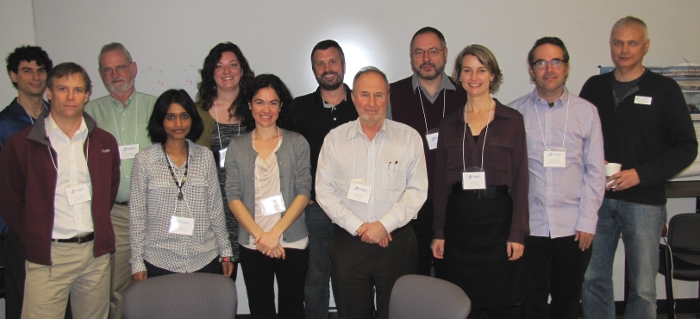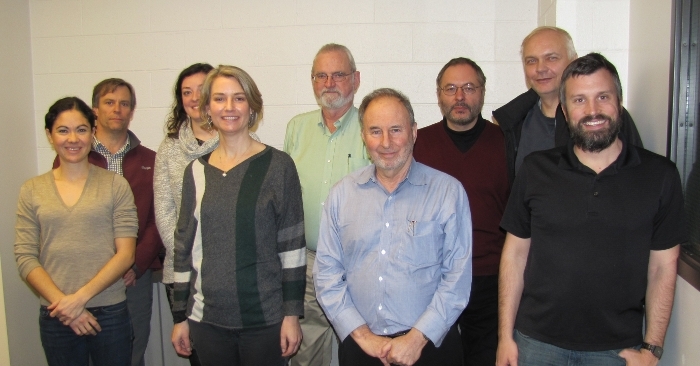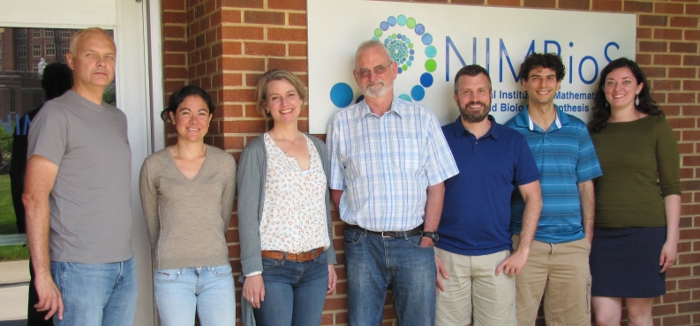| Description | Participants | Summaries | Products |
|---|

Archived NIMBioS Working Group
Evolution of Institutions
Topic: The Evolutionary Origins of Complex Institutions
Meeting dates: March 13-14, 2014; February 11-13, 2015; May 6-9, 2015
Organizers:
Peter J. Richerson, Environmental Science and Policy, Univ. of California, Davis
Jenna Bednar, Political Science, Univ. of Michigan, Ann Arbor
Peter Turchin, Ecology and Evolutionary Biology, Mathematics, Univ. of Connecticut, Storrs
Objectives. A persistent puzzle in evolutionary biology is explaining why humans cooperate with much larger groups of non-kin than other animals. Over the past few decades mathematical and computational models of human genetic and cultural origins have begun to tease apart the conditions necessary for the evolution of small-scale cooperative societies. However, most humans today live in large complex societies of the type normally studied by political scientists and institutional economists. This working group seeks to develop mathematical and computational tools for understanding the evolutionary transition from relatively small-scale societies to large-scale institutional organizations, such as complex chiefdoms, empires, and nation states.
Since this research exists where the current "bottom-up" approach of evolutionary biology and anthropology the "top-down" approach of political science and economics intersect, this working group incorporates mathematically and evolutionarily-oriented researchers from these disciplines as well as mathematical and computational modelers. Over the course of group meetings, we plan to foster a multidisciplinary review of various approaches to institutions as well novel collaborations between disciplines.

Meeting Summaries
| Mtg # | Dates | Agenda | Summary | Photo | Evaluation |
|---|---|---|---|---|---|
| 1 | Mar 13-14, 2014 | Link | Link | Report | |
| 2 | Feb 11-13, 2015 | Link | Link | ||
| 3 | May 6-9, 2015 | Link | Link |
Meeting 1 Summary. Our two-day initial meeting laid the groundwork for new collaboration and the working group's goals. We plan to write a common paper describing what is known, and particularly, what is unknown, about the evolution of institutions and the rise of complex human society. We also plan to generate a set of agenda-setting papers focused on particular topics related to the evolution of institutions. In preparation for the meeting, the organizers prepared a draft outline of the common paper and each participant submitted an essay describing their own research agenda. To facilitate the establishment of a common language and baseline for the group, the organizers opened the meeting with three short introductory talks on models of institutional theory, models of evolutionary theory, and the availability of data for testing models. We then discussed each participant's essay in turn, and the balance of the first day was spent determining a set of subtopics relevant for moving forward the research agenda on the evolution of institutions: (1) multi-level selection and the evolution of hierarchical institutions; (2) management of transitions and the relationship between formal and informal institutions; and (3) institutional innovation. During the second day we divided into three sub-working groups, each tasked with establishing a research agenda related to the research topics. These sub-working groups will collaborate during the next six months and present the status of their research at our second meeting, scheduled for this fall.
Meeting 2 Summary. Our two- and one-half day meeting concentrated on moving from the groundwork and collaborations formed in our first meeting to the actual formulation of models. Because several people had unavoidable conflicts and could not attend, we decided to reduce our three work groups to two, one focused on the emergence of inegalitarian, hierarchical societies from their ancestral egalitarian non-hierarchical ancestors. This transition, which occurred in the mid Holocene, as complex chiefdoms and the first states appear in the archaeological record, is one of the most important in our whole career as a species, partly because these systems, in turn, served as a platform for further increases in the size and complexity of institutions. It is fairly well documented archaeologically, and even protohistorically in the case of Hawai'i, but until we have formal models it is not possible to analyze the logic of the many explanations for the emergence of hierarchical, inegalitarian systems. The second group focused on institutional transitions and innovations. Increase in institutional complexity boils down to innovating new institutions faster than old ones are abandoned. To investigate this process, we need models of how institutional innovation functions. Historians and political scientists have developed a rich descriptive literature, but the complexity of the processes they describe has intimidated modelers. The task we set for ourselves to construct the simplest sort model(s) that can translate the ideas and actions of a population of political actors into an institutional innovation and developing an agenda for modeling factors left out of the simplest model(s). Transitions are historical phenomena that are qualitative shifts in social systems, such as the transition from highly inegalitarian low productivity agrarian societies to politically inclusive, high productivity societies in the last few centuries. Such transitions might result from institutional innovations with outsized effects or from an initially slow change that suddenly becomes much more rapid due to accumulating non-linearities in a complex system, without any need for institutional innovations with outsized effects.
Meeting 3 Summary. The third meeting of the Working Group was devoted to further development, refinement, and numerical testing of the agent-based model, developed by subgroup 1 in the second meeting, for the emergence of a hierarchical, non-egalitarian society from an egalitarian, acephalous society (implemented in R). Subgroup 2 developed a general model framework to capture the process of institutional innovation. This framework is designed to serve as a device to frame the general question of institutional innovation in away that acknowledges the issues as developed in the several disciplines contributing to this problem. Operational models are necessarily simplified realizations of the general model and will excite undue skepticism from scholars whose disciplinary focus is on a different set of simplifications.
 |
| (L to R): Russell Golman, Marty Anderies, Peter Richerson, Sarah Mathew, Amanda Robinson, Olivia Woolley Meza, Matt Zefferman, John Roemer, Peter Turchin, Jenna Bednar, Marco Janssen, Sergey Gavrilets. (Not Pictured): Jean Clipperton, Daria Roithmayr |
 |
| Mtg. 2 participants (L to R): Olivia Woolley Meza, Marty Anderies, Amanda Robinson, Jenna Bednar, Peter Richerson, John Roemer, Peter Turchin, Sergey Gavrilets, Matt Zimmerman. (Not pictured): Sarah Matthew |
 |
| Mtg. 3 participants (L to R): Sergey Gavrilets, Olivia Woolley Meza, Jenna Bednar, Peter Richerson, Matt Zefferman, Russell Golman, Amanda Robinson. |
NIMBioS Working Groups are chosen to focus on major scientific questions at the interface between biology and mathematics. NIMBioS is particularly interested in questions that integrate diverse fields, require synthesis at multiple scales, and/or make use of or require development of new mathematical/computational approaches. NIMBioS Working Groups are relatively small (up to 10 participants), focus on a well-defined topic, and have well-defined goals and metrics of success. Working Groups will meet up to 3 times over a two-year period, with each meeting lasting up to 2.5 days.
A goal of NIMBioS is to enhance the cadre of researchers capable of interdisciplinary efforts across mathematics and biology. As part of this goal, NIMBioS is committed to promoting diversity in all its activities. Diversity is considered in all its aspects, social and scientific, including gender, ethnicity, scientific field, career stage, geography and type of home institution. Questions regarding diversity issues should be directed to diversity@nimbios.org. You can read more about our Diversity Plan on our NIMBioS Policies web page. The NIMBioS building is fully handicapped accessible.
NIMBioS
1122 Volunteer Blvd., Suite 106
University of Tennessee
Knoxville,
TN 37996-3410
PH: (865) 974-9334
FAX: (865) 974-9461
Contact NIMBioS


